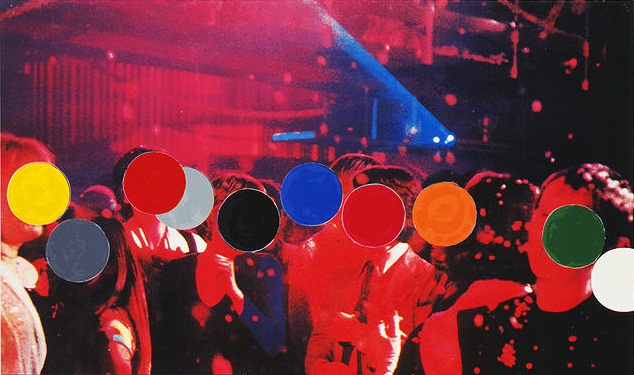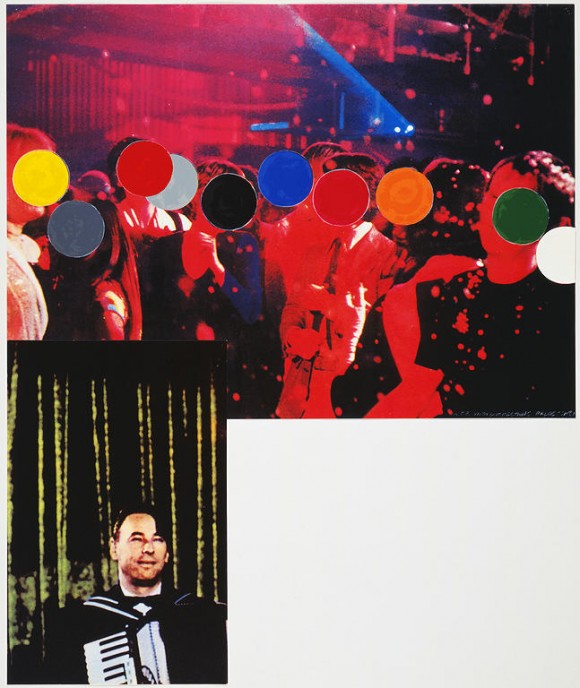
The Art of Writing about Art Part 2: Baldessari's Discontent? I
November 10, 2015
Baldessari’s Discontent? Part I
For their first formal analysis assignment, several students in ART 261 chose to write about John Baldessari’s 1994 lithograph Accordionist (With Crowd). Grace Jones (Freshman, History) explains why determining meaning in Accordionist (With Crowd) is so challenging:
“Each face in the “crowd” is concealed by a large, colorful dot, giving viewers no facial cues to determine what they are feeling. The accordionist’s face is clearly shown but could be construed as positive or negative depending on how the viewer conceives the crowd to be reacting. The colorful spots would suggest a happier scene but the blurred and darkened background contradicts that, creating visual confusion and an ominous atmosphere. In addition, the camouflaged faces direct the viewer to take note of other elements of the image, like the background and positioning of the crowd. The contradictory components of the work (tone value, color and imagery) make it unclear whether or not the image should be perceived as a positive or negative. All the elements of the piece require a more conscious and involved viewer, making the imagination and mind as important as the details themselves.” Accordionist (With Crowd) suggests a narrative, but what exactly is the moral of the story and how do we, as viewers, arrive at it?
Rebecca Malkin (Freshman, English) offers one reading, beginning with a key element: the title. Malkin notes that “[t]he title of the piece insinuates a relationship while distinguishing the main subject, the accordionist, from the crowd by parentheses. Baldessari refers to the subjects as a crowd, which is usually associated with rowdiness and informality, rather than a respectful audience. Both the format and diction of the title suggest the crowd’s disinterest toward the performer who fails to connect with his audience.”
On the work’s composition, Malkin observes that the overall composition is unstable. “While the crowd fills the space in the upper frame, the accordionist stands alone on the lower left-hand side, forming an asymmetrical composition that separates the two subjects. The detachment between the performer and the crowd is furthered by the physical overlap of the individual lithographs and the clear division of space between them. The placement of the images, the crowd above the musician, suggests a hierarchy in which the crowd has control over the musician by determining the success of his performance. The negative space of the lower right-hand side draws the viewer’s eye to the accordionist. In turn, his gaze draws a vertical line back up toward his center of interest, the crowd. The structured way Baldessari explores interaction between the space and the subjects further emphasizes their ambiguous relationship.”
In exploring that ambiguity, Malkin focuses on the crowd in the upper half of the work. “[S]upposedly gesturing and conversing under the guise of the colored dots, [they] appear to be in movement, juxtaposing with the accordionist who appears to be frozen in place and captured by the moment. The artist’s cancellation of the accordionist’s hands suggests that he has finished playing and has the expectation of the audience’s full attention. As his face is the only one visible, the focal point is on his proud yet pensive facial expression. The anonymity of the crowd due to the circles draws attention to their body language. Their bodies are turned away from the stage and their heads tilted as if in conversation which reveals their apathy toward the performance.”
In the end, Malkin argues that “Baldessari’s pop-art style, focus on the performer, and connection of realistic and abstract composition convey the universal issues of modern-day artists. The musician’s anticipative reaction contrasted by the lack of response from the faceless audience echoes the sentiments of contemporary artists competing to capture their audience’s attention and thirsting to receive recognition for their performance. The piece is an ode to the hardships of an artist.”


